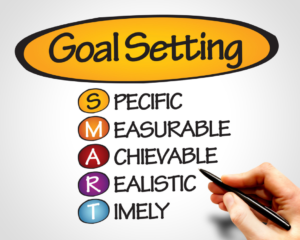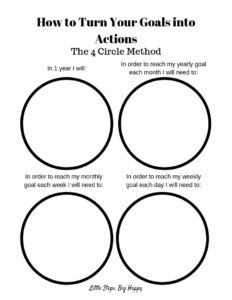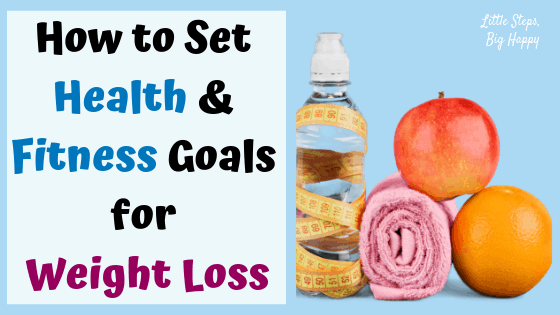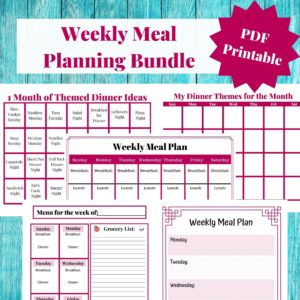Do you know the difference between a useful goal and a useless one? Today I want to talk about how to set useful goals for weight loss. That way you aren’t wasting that valuable time between feeding hungry kids and keeping the toddler alive. (All 5 minutes of it are precious!)

Useful Goals vs. Useless Goals
A useful goal is one that actually helps you create steps to reach your goal. A useless goal is a vague description of what we want our lives to be like.
A lot of us have “goals” for weightloss. We say things like:
-
“I want to be thin…”
-
“I want to eat healthy…”
-
“I want to lose weight…”
These sound great in theory, but they leave a lot of room for interpretation. Which leaves a lot of room for excuses, and justifications. They also don’t give a clear roadmap of what you need to do.

S.M.A.R.T. Goals
Useful goals follow the acronym S.M.A.R.T.
-
Specific – What exactly do you want to achieve?
-
Measurable – How can you measure your progress towards your goal?
-
Attainable – Is this goal something that you can realistically achieve?
-
Relevant – Is this goal relevant to what you want in your life?
-
Timely – Set a deadline for when your goal should be accomplished.
So by using the S.M.A.R.T. acronym, we could take our goal of ” I want to lose weight so I can be thin,” to “I want to lose 45 lbs in 6 months so I can weigh 140lbs.”
Now that we know a little bit more about what a useful goal looks like, let’s break it down a little further.
How to Set Goals for Weight Loss
Start with defining your end goal
The very first thing you want to do is imagine where you want to be when you are done. Think about that end goal that you are trying to get to.
Don’t worry about being stuck with whatever goal you choose. As you start working towards it, your priorities will change and you can always reassess. Right now it’s just important to set up the framework so you can get going as soon as possible.
To help better explain these concepts, I will stick with the same goal of “I want to lose 45 lbs in 6 months,” for my example.
Decide your time frame for your goal
So in the example we are using, we picked 6 months. If the goal you picked is bigger, you might choose 9 months, a year, 18 months. All of those options are ok.
You just want to make sure your timeframe is realistic. For weight loss especially, I think it’s better to err on the side of more time than you might need.
Losing weight has a lot of ups and downs. Your body might lose weight rapidly in the beginning, stall out for a while, lose some more weight, gain a few pounds back, etc. You want a time frame that encourages you to keep going, while not pressuring you to get crazy results every single day.
Plus most experts agree that losing 1-2 lbs a week is a healthy goal. So if our weight loss goal is 45 lbs, 6 months is a very realistic time frame to get it done. And hey, if you achieve your goal earlier, all the better!

Break your goal down into bite-size pieces
Now, this next step in how to set goals for weight loss is the moneymaker! This is the one that I find makes all the difference for most people. (It’s like that feeling you have when you finally meet the mom friend who totally gets you.) We are going to take that long term goal and break it down into small bite-size pieces.
So first we will take our goal of 45 lbs in 6 months and break that down into monthly goals. Our monthly goal would be 7.5 lbs a month. We take our monthly goal and break it down into weekly goals. Our weekly goal would be 1.9 lbs.
We went from the idea of losing 45 lbs, which might seem a bit intimidating or overwhelming to simply losing 1.9 lbs a week. Now I don’t know about you, but losing 1.9 lbs a week feels a whole lot more doable.
It still fully aligns with our long term goal, but it gives us something more manageable to focus on during our day-to-day.
Click HERE to download your own copy of How to Turn Your Goals into Actions Worksheet to help you break down your long-term goal into bite-size pieces.
Identify all of the daily and weekly steps you can take to reach your goal
Here is where we get into the nitty-gritty of setting our goals. Once we know what our goal is, we need to write down all of the actions we need to take to achieve it. A goal without actions to back it up is like a car without gas. It doesn’t work.
So if our goal is to lose 45 lbs, we need to write down all of the things we could do each day or week that will help us reach them. Some examples might be:
-
exercising regularly
-
eating more vegetables
-
drinking 64 oz of water daily
-
getting 7-9 hours of sleep each night
-
meal planning
-
meal prepping
-
journaling your food
-
24-hour meal plan
These are just some of the things that I have done to lose weight and that I do now to help maintain my weight. Your list might look a little different. Just write down all of the things that you can think of that will help you lose weight.
Break your goals down even smaller
Now that you have written down all of the things you can do to lose weight, break those down into even smaller actions. For example, you could take drinking 64 oz of water and break it down into:
-
drink 1 cup of water as soon as I wake up
-
drink 1 cup of water before I drink juice or soda
-
drink 1 cup of water before bed
-
drink 1 cup of water after I exercise
-
drink 1 cup of water before each meal
The whole point of this exercise is to create super small achievable steps we can build on as we create these new habits that support our goal. If you are currently barely drinking water, then trying to start drinking 64 oz of water a day is definitely a stretch.
You might try for a day or two, struggle, and find yourself sipping on Starbucks and soda by the end of the week instead of your water. We are going to talk about how to use these super small tasks next.
Add in 1-4 new habits a week
Now that you have broken down all of your daily/weekly actions into super small tasks, pick 1-4 tasks a week to start adding in. Pick only 1-4 new habits to try for the week. And pick the ones you know you will be able to follow through on.
I’m talking like 80-90% confidence you will do it. So if that’s just drinking 1 cup of water first thing in the morning, then that’s perfect!
Maybe you are feeling good and you want to drink 1 cup of water in the morning, go for a walk 3 days a week, and try to go to bed at 10 pm instead of 11 pm. Those seem like small steps, but if that’s what you can commit to, then that is exactly the place to start.
If you downloaded the How to Turn Your Goals into Actions Worksheet, you can fill in your weekly and daily actions on this as well.
Why can’t I start everything at once??
I know it can be tempting to go all out and overhaul your whole life. It sounds great because you think you will just achieve all of your results that much faster right?
Well… wrong! Because it doesn’t work. It’s not sustainable. It’s motivating for like a day or two maybe and then it gets difficult and a little miserable and your brain is screaming for some relief.
Motivation is one of the biggest struggles that people have when trying to lose weight. People think motivation just comes and goes and that something is missing when you don’t feel motivated.
The reality is motivation is built off of small wins and successes. First, you have to practice committing to the mini-goals you set for yourself. Then you take that positive momentum from following through on those tasks to help you work towards the next ones.
It starts with drinking one glass of water. Then you work on 2 glasses, then 3 glasses, and next thing you know you are drinking all 64 oz a day and it doesn’t take a herculean effort to do it.
Master one mini-goal before you try to add another one
The next step in how to set goals for weight loss is knowing when to add in more habits. You want to focus on mastering your current mini-goal before you move on to a new one.
I know sometimes it can be frustrating if you are feeling like you aren’t moving as fast as you want to. And maybe you feel like you aren’t doing enough to achieve your goal.
Try to keep in mind though, that adding in more tasks when you are still struggling to master one isn’t going to make anything easier. In fact, it will have the opposite effect.
It’s like when children are learning to read. First, they are introduced to the alphabet. Once they have mastered that they move on to letter sounds, then phrases, then short sentences, and so on and so forth. It would make no sense to try to teach a child how to read phrases and short sentences if they still haven’t mastered the alphabet.
The point isn’t necessarily to race to finish line as fast as possible. The point is to do the work to achieve your goal in a method that is sustainable. You want a nice slow and steady build of momentum that you can maintain for the rest of your life.
Keep leveling up your mini-goals until you reach your final long term goal
Once you get the hang of mastering a mini-goal and adding in new ones, you will see your motivation and success start to keep building and building. What once was difficult starts to get a little easier and easier. Then you will naturally want to start challenging yourself to do a little more.
Once you master drinking 64 oz of water a day, you might start feeling confident enough to try a new workout or maybe give meal planning a try.
Eventually, you will start tackling some of the harder challenges on your list of weight loss steps. Each new task and habit that you develop will help further you towards your eventual end goal.
Final thoughts on how to set goals for weight loss
Along the way, your goals may change and you realize you need to reevaluate. Then you just start back at the top. What’s wonderful though, is you will get to take the momentum and motivation from your original goal with you towards the new one.
You will have already learned how to follow through and commit to the steps you have outlined for yourself. Knowing how to set goals for weight loss is a skill that you can transfer to all areas of your life.
If you have any questions or advice that you would like to add, comment below or email me at Candice@littlestepsbighappy.com. Also, follow me on Pinterest for more motivation and advice about weight loss.
Looking for more weight loss tips?
- 7 Quick Weight Loss Tips for Busy Moms
- How to Keep a Food Journal for Effective Weight Loss
- 10 Simple Tips to Help You Lose Weight on a Budget
- 7 Simple Tips to Avoid Holiday Weight Gain This Year
- How to Take Body Measurements for Weight Loss: Step-by-Step Tutorial
- 9 of the Best Morning Habits for Weight Loss
- 10 Habits You Need to Break to Lose Weight for Good
- 21 Small Diet Changes to Lose Weight for Good
- 5 New Year’s Resolutions to Lose Weight This Year
- 5 Ways Coaching for Weight Loss Speeds Up Your Progress
- How to Lose Weight Without Starving: Smart Tips to Try Today!
- Scale Not Moving? 12 Reasons Why & What You Can Do About it
Pin this for later!

You might also like:




I’m a busy mom of 3 turned Health and Fitness Coach and Self Defense Instructor. I help inspire other moms to reach their health, fitness, and weight loss goals. You can usually find me chasing my kiddos around, training Brazilian Jiu-Jitsu, or sneaking away to read romance novels. About Me






